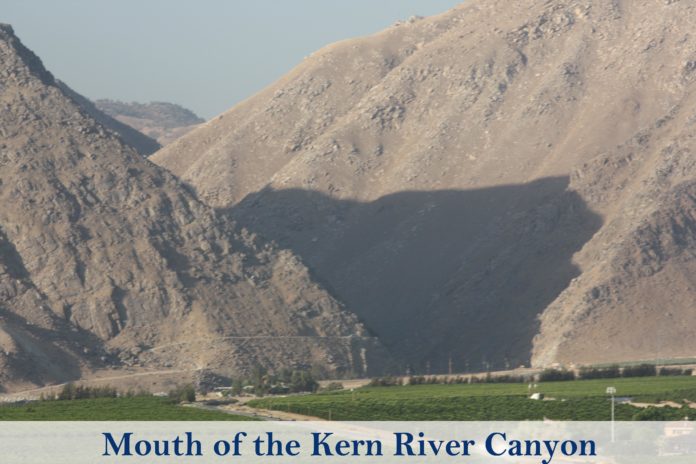The Kern Groundwater Authority Groundwater Sustainability Agency held its Wednesday, June 28, 2023 board of directors meeting in Bakersfield, I believe at the new Kern County Farm Bureau offices. President Dan Waterhouse called the meeting to order at 8:00am and we saluted the flag as a government meeting should do.
The Meeting
There was no public comment and the first item was supposed to be a presentation by Laura Jensen from the California Water Commission on how to help communities and species during drought. But she couldn’t be heard on Zoom. Bless her heart, I think we’ve all been there.
The minutes were approved and the KGA has a new treasurer. Marinelle Duarosan wasn’t at the meeting, I guess. Her boss Dave Hampton gave the report and it was accepted. Executive Director Patty Poire said she had a check for Todd Groundwater and Land IQ for services. The money came from grant funds.
CWC Program
Poire introduced Jensen who was by then online. She said this is part of the governor’s water portfolio and Jensen will be giving the same presentation that will be the CWC’s official position. I think.
Jensen said this plan is coming from the governor’s cabinet level direction. There are monthly public meetings to discuss policy. There are also talks about Prop One’s $2.7 billion fund for surface storage. There are still two of the nine CWC seats unfilled.
Jensen said the topic of drought is much more complicated than expected since there is climate change and naturally occurring drought. The water resilience goals are for droughts lasting at least six-years. Drought impacts can be felt almost immediately or last for a decade in some cases. After engaging experts, interested parties and the public a white paper will be drafted.
Just yesterday I completed a survey by the CWC about this topic. It wasn’t too bad and allowed some comments. You should take it too and you’ll get an idea of where this is going.
 There is a drought working group formed to look at strategy: surface storage was one of the solutions looked at. Four preliminary strategies are being developed.
There is a drought working group formed to look at strategy: surface storage was one of the solutions looked at. Four preliminary strategies are being developed.
Jensen said the state can develop some dedicated drought capacity to coordinate between agencies instead of an ad-hoc type of response. The state wants tribes and NGOs to get their nose and nuts in the middle of it. Better seasonal forecasting is needed and more public outreach.
No offense to Ms. Jensen but it would be good to remember many NGOs are special interest groups and many tribal representatives come from NGOs.
Groundwater recharge is the new go to, thankfully. Permitting and infrastructure are at least on the radar for improving recharge efforts.
Ecosystems at the watershed level was the topic where I could no longer type fast enough to keep up with the presentation. Again, please understand, no offence to Ms. Jensen this is coming from higher up but this presentation left me with many questions, the biggest one being – so? Kern County has some big problems, the state has some big problems and the CWC hasn’t exactly knocked it out of the park with its Prop One administration. (I understand the CWC board members earn a $100 per meeting stipend.)
If this follows the usual government path set by the SGMA example NGOs hostile to agriculture will receive a big chunk of change to do outreach. Then these NGOs will criticize the local folks in charge of implementation for not doing enough to promote public outreach.
Just this week The Nature Conservancy, the Union of Concerned Scientists, the National Audubon Society and Clean Water Action issued a press release about a new report “authored by experts” that finds – Surprise! – more than 100 Groundwater Sustainability Plans “overlook the state’s most vulnerable groundwater users.”
The report helpfully recommends “leveraging state funding to increase stakeholder integration.” That’d be nice if the money goes to the GSAs that are actually doing the work.
The report recommends, “Updating and expanding SGMA guidance to GSAs to ensure protection of vulnerable users.” We need SGMA or at least some path to preserve groundwater. Reduced surface deliveries forced changes in cropping and irrigation methods which in turn contributed to increased acreage and less recharge, exacerbating the problem of over-draft. There is a very real danger of too many cooks proscribing legislative and regulatory pile-on of SGMA guidance. Although there are plenty of folks in Sacramento who would like to recreate SGMA in their image, constantly moving the goal posts for the GSAs isn’t the answer.
The report wants information gaps closed. It says these gaps are “critical for tracking the impact of groundwater management on all users.” Will the authors of the press release be funding data collection efforts? That would be helpful as long as unbiased investigations were taking place.
In other states and foreign countries SGMA type laws were written after years of investigation and study. In California our first major groundwater law was written before recharge was even considered a beneficial use. SGMA was written so there would be local control and a goal of achieving groundwater balance was set for 20-years. All of the formation of GSAs has been completed, the GSPs have been written within the deadline, projects to implement the plans are underway. No one knows exactly how to accomplish the goals. And SGMA wasn’t designed to protect DACs from inadequate wells or a solution to environmental goals, but the GSAs are trying.
In summation, here’s a data gap for you – when incorporating climate change into the GSPs perhaps some state funding and guidance of how much the climate is going to change and when can be provided.
Attorney’s Report
Valerie Kincade said AB 460 has been moved to a two-year bill status. This is great news and common sense has prevailed at least for now. A very intense and coordinated opposition emerged, really one of the biggest push backs against any legislation to come along in a while.
Reporting on a meeting of the Bay Delta Plan there will be a Sacramento/Delta flows plan released at the end of the summer that will include beneficial uses for tribes. There was a presentation by tribes about cultural uses for flows. Kincade said there were very pointed and critical questions asked of State Water Resources Control Board members. There was criticism about the Voluntary Agreements and charges of racism of course.
The State Board had a SGMA workshop to establish a timeline to deal with the six deficient GSPs: Tulare Lake, Tule and Kern Subbasins have all been put to the front of the line. However, this wasn’t adopted and no notices have gone out. Kincade said it looks like Kern may receive notice this December with a probationary hearing in April. She said the State Board is indicating it is willing to allow the players to revise their GSP before the probationary hearing. But Kincade is concerned with the lack of defined process but also some rays of sunshine in as much as the State Board didn’t indicate it is in any hurry to take over.
However, this wasn’t adopted and no notices have gone out. Kincade said it looks like Kern may receive notice this December with a probationary hearing in April. She said the State Board is indicating it is willing to allow the players to revise their GSP before the probationary hearing. But Kincade is concerned with the lack of defined process but also some rays of sunshine in as much as the State Board didn’t indicate it is in any hurry to take over.
This is encouraging news and one wonders how the State Board is going to control all the wells from all the landowners and who owns what. Perhaps reality has made a noticeable presence. As the State Board gets into the revisions and starts trying to deal with a probationary period – things could easily enter overwhelming territory for all involved.
John Davis of Davis Engineering just revised the Chowchilla Subbasin GSP and submitted it to DWR back in May. He said the desire is to have DWR review this, bring back suggestions and avoid any probationary period. The board seemed pleased to hear what Davis had to say and there may some tweaking of the Kern Subbasin GSP in the near future.
Subsidence
Aquilogic has been working on a subsidence plan for the KGA. Poire said members need to let her know who is interested in further subsidence planning participation. Kincade will draw up a special agreement and assign a cost share. Poire said there is no one who understands subsidence in the Kern Subbasin like Aquilogic. The KGA membership is in flux. Last month five members submitted letters of intent to leave KGA and North Kern WSD will no longer provide accounting and bookkeeping services. It certainly does appear a special agreement with cost sharing is the way to go at this time.
understands subsidence in the Kern Subbasin like Aquilogic. The KGA membership is in flux. Last month five members submitted letters of intent to leave KGA and North Kern WSD will no longer provide accounting and bookkeeping services. It certainly does appear a special agreement with cost sharing is the way to go at this time.
Closed Session
The meeting went into closed session at 8:58am for two items.
DISCLAIMER OF RESPONSIBILITY; Waterwrights strives to provide his clients with the most complete, up-to-date, and accurate information available. Nevertheless, Waterwrights does not serve as a guarantor of the accuracy or completeness of the information provided, and specifically disclaims any and all responsibility for information that is not accurate, up-to-date, or complete. Waterwrights’ clients therefore rely on the accuracy, completeness and timeliness of information from Waterwrights entirely at their own risk. The opinions expressed in this report are those of the author and do not represent any advertisers or third parties.
ALL RIGHTS RESERVED. Copyright 2023 by Waterwrights.net.
SGMA The Sustainable Groundwater Management Act of 2014 calls for the formation of Groundwater Sustainability Areas within Basins and Sub-basins to develop Groundwater Sustainability Plans.
Staff: Patty Poire – Executive Director, Valerie Kincade – Attorney, Marinelle Duarosan – Treasurer
The Kern Groundwater Authority membership:
Chair Dan Waterhouse – Semitropic WSD, Royce Fast – Kern County WA, Andrew Pandol – Kern Tulare WD, Kim Brown – Kern Water Bank Authority, , Gary Morris – West Kern WD & Rob Goff – Westside District Water Authority.
Intending to Withdraw – Brandon Morris – Southern San Joaquin MUD, John Gaugel – Cawelo WD, Kevin Andrew – North Kern WSD, Gary Unruh – Rosedale Rio Bravo WSD, Randy Bloemhof – Shafter Wasco ID
DWR Listing: Basin San Joaquin, Sub Basin Kern 5-022.14

































